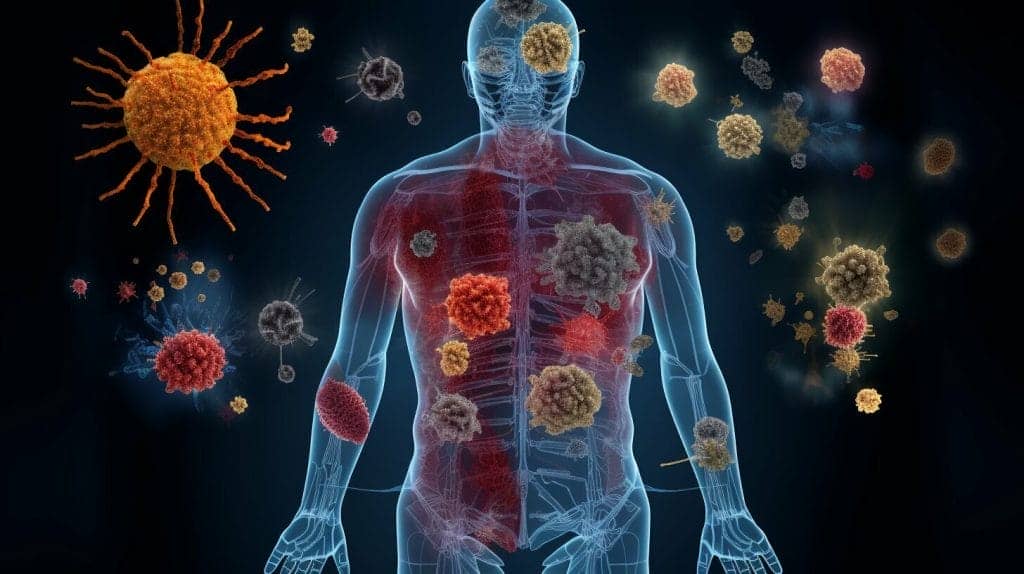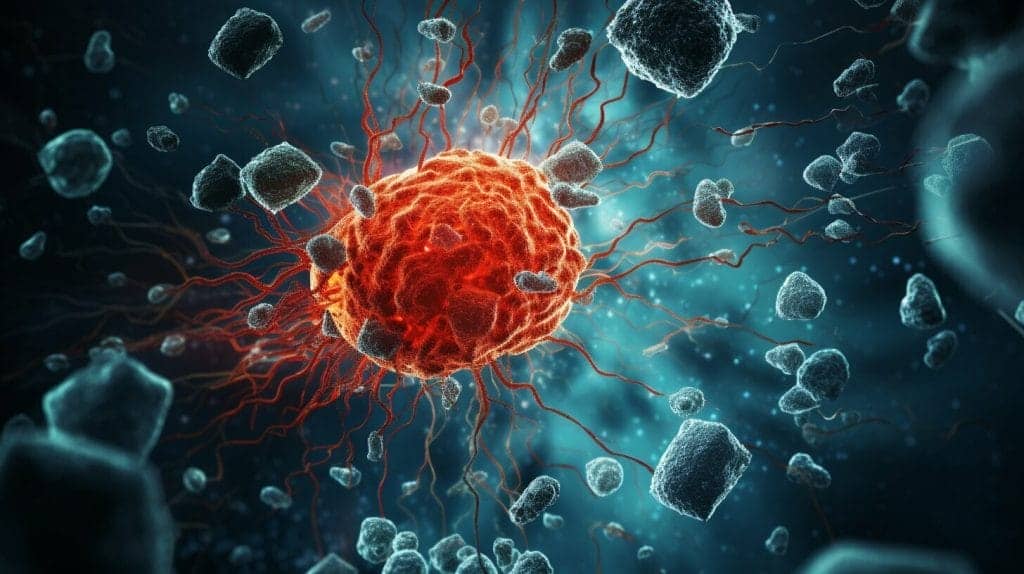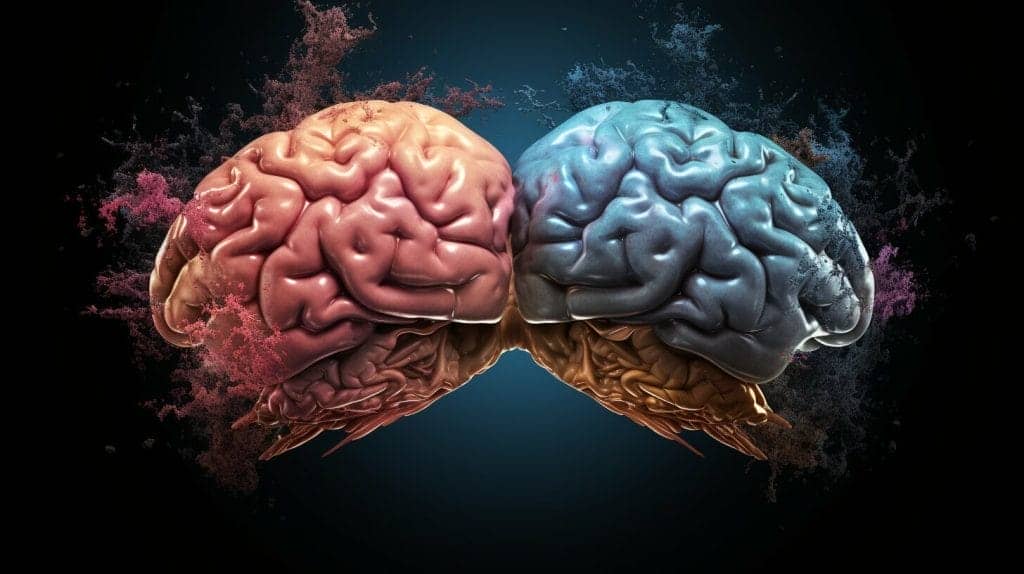The COVID-19 pandemic has highlighted the importance of understanding the virus and its behavior. At the heart of the virus is the spike protein, which plays a critical role in viral entry and replication.
In this article, we will delve into the structure and function of the COVID spike protein, exploring its interaction with human cells, the emergence of variants, and the implications for vaccine development. We will also discuss the latest research on the spike protein and its potential impact on healthcare strategies.
Key Takeaways:
- The COVID spike protein is a critical component of the virus, playing a key role in viral entry and replication.
- Understanding the structure and function of the spike protein is crucial for developing effective treatments and vaccines.
- Ongoing research on the spike protein is essential for combating the virus and mitigating its impact on global health.
Structure of the Spike Protein
The COVID-19 virus is covered in “spike” proteins that allow it to attach and enter human cells. These spikes are made up of three identical protein subunits that cluster to form a trimeric structure.
Each subunit consists of two functional domains: the S1 domain, which contains the receptor binding motif (RBM), and the S2 domain, which includes the fusion machinery responsible for viral entry into host cells.
The S1 domain has a receptor-binding site that recognizes and binds to the ACE2 receptor on human cells, allowing the virus to enter and infect the host. Mutations in this region have been linked to increased infectivity and the emergence of new variants, such as the Delta variant.
Crystal Structure of the Spike Protein
Researchers have used advanced imaging techniques, such as X-ray crystallography and cryogenic electron microscopy (Cryo-EM), to determine the 3D structure of the spike protein at high resolution. These efforts have provided valuable insights into the architecture and function of the protein, as well as potential targets for therapeutics and vaccines.
Function of the Spike Protein
The COVID-19 virus spike protein plays a critical role in virus transmission and infection. The spike protein is composed of three distinct domains: the receptor-binding domain (RBD), the N-terminal domain (NTD), and the S2 subunit.
The primary function of the spike protein is to facilitate viral entry into host cells by binding to the angiotensin-converting enzyme 2 (ACE2) receptor on the surface of human cells. The RBD domain of the spike protein engages with the ACE2 receptor, triggering a conformational change that allows the virus to fuse with the host cell membrane and release its genetic material into the cell.
Once inside the cell, the virus uses its own machinery to replicate and produce new virus particles. The spike protein also plays a crucial role in evading the immune system, as it is a major target for neutralizing antibodies. The NTD domain of the spike protein can mutate rapidly, allowing the virus to evade recognition by the immune system and persist in the host.
Interaction with Human Cells
Once the COVID spike protein binds to a human cell, it undergoes a conformational change that allows it to fuse with the cell membrane. This fusion enables the virus to enter the cell and hijack the host’s cellular machinery for its own replication.
The COVID spike protein interacts with human cells through the angiotensin-converting enzyme 2 (ACE2) receptor, which is expressed on the surface of many different types of cells in the body. The spike protein binds to the ACE2 receptor with high affinity, allowing the virus to target and infect a wide range of cells.
Additionally, recent studies suggest that the COVID spike protein may also interact with other cellular receptors and proteins, such as neuropilin-1, which could further contribute to its pathogenesis. Ongoing research aims to uncover the full extent of these interactions and their implications for virus transmission.
Variants of the Spike Protein
The COVID-19 virus is highly adaptable, and as a result, several variants of the virus have emerged since the initial outbreak. These variants have unique mutations in their spike proteins, which can affect the virus’s ability to infect cells and evade the immune system.
The Delta variant, first identified in India, is currently the most prominent variant of concern. It has several mutations in the spike protein, making it more infectious and potentially able to evade some existing antibodies.
| Variant | Country of Origin | Notable Mutations |
|---|---|---|
| Alpha | United Kingdom | N501Y, P681H |
| Beta | South Africa | E484K, N501Y |
| Gamma | Brazil | E484K, N501Y, K417T |
| Delta | India | L452R, G142D, T478K |
It is important to note that while these variants may have different spike proteins, the fundamental mechanisms of the virus remain the same. This means that vaccines and treatments targeting the spike protein can still provide significant protection against these variants.
Research is ongoing to assess the potential impact of these variants on vaccine effectiveness and virus transmission. Vaccine manufacturers are also working to develop booster shots that specifically target these variants, potentially providing additional protection.
Role of Spike Protein in Vaccine Development
The COVID-19 pandemic has highlighted the urgent need for effective vaccines to protect individuals and communities from the virus. Spike proteins from the COVID virus have played a critical role in the development of several COVID-19 vaccines.
These vaccines work by training the immune system to recognize and fight the virus, with the spike protein as the target of the response. By introducing a harmless version of the spike protein into the body, the vaccine stimulates the production of antibodies that can recognize and neutralize the actual virus.
One of the most widely used vaccines for COVID-19 utilizes RNA technology which prompts cells in the body to replicate a harmless version of the spike protein. The body then launches an immune response against this protein, creating a defense against the virus.
Other vaccines, like the Johnson & Johnson and AstraZeneca vaccines, utilize a viral vector that carries the instructions for creating the spike protein into human cells. These vaccines work in a similar way, prompting the immune system to recognize and attack the virus.
The efficacy of these vaccines has been demonstrated in large-scale clinical trials, with many showing high levels of protection against severe illness and hospitalization. However, the emergence of variants of the COVID virus, some of which have mutations in the spike protein, has raised concerns about the continued effectiveness of these vaccines.
Research is ongoing to develop new and improved vaccines that can target these variants and provide ongoing protection against the virus. The versatility of the spike protein as a target for the immune system makes it a key player in the ongoing fight against COVID-19.
Research on the Spike Protein
The COVID spike protein has been the subject of intense research since the beginning of the pandemic, with scientists around the world working to better understand how the virus functions and how it can be effectively treated. Recent studies have shed light on key aspects of the spike protein’s behavior, including its role in viral entry and its ability to evade the immune system.
One notable area of research has focused on the emergence of spike protein variants, which are believed to be more contagious and potentially more resistant to existing vaccines. Scientists are working to better understand the specific mutations that give rise to these variants and to develop new treatments and vaccines that can effectively combat them.
Research Advances:
“Our current understanding of the COVID spike protein is constantly evolving, as new research emerges and new treatments are developed. By continuing to invest in basic and clinical research, we can deepen our understanding of the virus and develop more effective strategies for combating it.”
Other areas of research have focused on the use of spike proteins in vaccine development. Researchers have found that the spike protein is an effective target for vaccines, as it triggers a strong immune response that can provide protection against the virus. Ongoing studies are exploring the efficacy of different vaccine formulations and dosages, as well as the potential for booster shots to maintain immunity over time.
Overall, the research on the COVID spike protein is a critical component of our ongoing efforts to understand and combat the virus. By staying up-to-date on the latest findings, healthcare professionals can better tailor their treatment strategies and public health measures to effectively manage the pandemic.
Implications for Healthcare
The COVID spike protein has significant implications for healthcare systems worldwide. The virus’s ability to spread rapidly and efficiently has put a strain on hospitals and healthcare professionals, leading to shortages of resources and increased risk of exposure.
The spike protein plays a crucial role in viral entry and replication, making it a potential target for vaccine development and treatment strategies. As such, ongoing research on the spike protein’s behavior and structure is essential to combatting the virus and preventing its spread.
Impact on Hospitalizations
The emergence of COVID-19 variants with increased transmissibility has led to a surge in hospitalizations, particularly among unvaccinated individuals. The spike protein’s ability to bind with human cells and facilitate viral entry has made it a key target for treatment and prevention efforts.
By understanding the mechanisms behind viral transmission and the role of the spike protein, healthcare systems can better prepare for and manage outbreaks of COVID-19. This includes measures such as increasing ICU capacity and securing adequate PPE supplies for healthcare workers.
Treatment Strategies
Targeted therapies that focus on blocking the spike protein have shown promise in mitigating the impact of COVID-19. These treatments work by preventing the virus from binding to human cells, thereby reducing viral load and preventing severe illness.
Other treatments under investigation include monoclonal antibodies and antiviral drugs, which aim to target specific aspects of the virus’s structure and behavior. As research on the spike protein continues, healthcare professionals will have a better understanding of how to treat and prevent COVID-19.
Holistic Treatments at Oasis Medical Institute
Oasis Medical Institute, located in Tijuana, MX, is known for its integrative approach to medicine for COVID-19 patients. Medical director Dr. Francisco Contreras MD and his team of experts offer advanced, holistic treatments to help combat the virus and promote overall health and wellness.
| Treatment Options | Description |
|---|---|
| IV Therapy | Customized intravenous therapy that delivers nutrients, vitamins, and minerals directly into the bloodstream to boost immune function. |
| Oxygen Therapy | High-dose oxygen therapy to increase oxygen levels in the body and aid in the recovery process. |
| Nutritional Counseling | Personalized nutrition plans to support immune function and overall health. |
| Immune-Boosting Supplements | Natural supplements to strengthen the immune system and aid in the healing process. |
| Mind-Body Practices | Techniques such as meditation and yoga to reduce stress and promote healing. |
At Oasis Medical Institute, patients receive individualized care and comprehensive treatment plans that address all aspects of their health. Their holistic approach has been shown to improve outcomes for COVID-19 patients, and they continue to lead the way in integrative medicine.
Consultation and Treatment Program
For those seeking integrative treatment options for COVID-19 that focus on the importance of understanding the spike protein, Oasis Medical Institute offers a comprehensive treatment program. Led by medical director Dr. Francisco Contreras MD, the program combines conventional medicine with alternative therapies, ensuring a holistic approach to COVID-19 treatment.
To book a consultation and enroll in the program, interested individuals can contact Oasis Medical Institute at [INSERT CONTACT DETAILS]. During the consultation process, patients can expect to receive a personalized treatment plan that addresses their unique medical needs.
Latest Advancements in COVID-19 Treatment
The COVID-19 pandemic has spurred significant research efforts aimed at developing effective treatments to combat the virus. In recent months, there have been several notable advancements in this area, particularly in relation to targeting the COVID spike protein.
One strategy that has shown promise is the use of monoclonal antibodies, which are laboratory-produced molecules that can mimic the immune system’s ability to fight off viruses. Several monoclonal antibodies that target the COVID spike protein have been developed and have received emergency use authorization from the FDA. These treatments have shown to be effective in reducing hospitalization rates among high-risk patients.
Another promising approach is the development of small molecule inhibitors that can block the interaction between the COVID spike protein and human cells. These inhibitors have shown potential in preventing viral entry and replication and are currently undergoing clinical trials.
Advanced treatment techniques such as extracorporeal membrane oxygenation (ECMO) and convalescent plasma therapy are also being used to treat severe cases of COVID-19. These techniques involve filtering and enriching blood with anti-COVID antibodies to support the immune system.
As research continues, it is likely that new and innovative treatment strategies will emerge, offering hope to those affected by the virus. However, it is important to maintain caution and follow public health guidelines to limit the spread of COVID-19.
Future Directions in Spike Protein Research
The COVID-19 pandemic has highlighted the need for continued research on the spike protein in order to better understand its behavior and develop effective strategies for combating the virus. As such, numerous research groups around the world are actively pursuing different avenues of investigation to gain a deeper understanding of this critical component of the virus.
One promising area of research involves the use of computational modeling to better understand how the spike protein interacts with human cells. By simulating the behavior of the protein at the molecular level, researchers hope to identify potential drug targets that could be used to block its activity and prevent viral transmission.
Other research teams are exploring the use of monoclonal antibodies, which are lab-made proteins that can bind to the spike protein and prevent it from entering human cells. These antibodies could be used as a treatment to prevent COVID-19 infection in individuals who have been exposed to the virus, or as a preventative measure in high-risk populations.
Another exciting area of research involves the development of novel vaccine strategies that target the spike protein in different ways. For example, some researchers are exploring the use of RNA-based vaccines, which encode the genetic blueprint for the spike protein and stimulate an immune response without using live virus particles.
As research on the COVID-19 spike protein continues to evolve, it is important to remain vigilant and responsive to new developments in the field. By working together and sharing knowledge, researchers can continue to make important strides in our understanding of this critical component of the virus and develop effective treatments and preventative strategies to stop the spread of COVID-19.
Conclusion
In conclusion, understanding the COVID spike protein is crucial in the battle against the coronavirus pandemic. As discussed in this article, the spike protein plays a critical role in virus transmission and infection. By delving into the structure and function of the spike protein, researchers can develop effective vaccines and treatments to combat the virus.
The emergence of spike protein variants, such as the Delta variant, highlights the need for continued research and vigilance. Ongoing studies will aim to deepen our understanding of the behavior of the spike protein and develop new strategies to mitigate its impact on human health.
The importance of the COVID spike protein for healthcare systems cannot be overstated. Hospitals around the world have seen a surge in hospitalizations due to COVID-19, putting immense strain on healthcare resources. By understanding the behavior of the spike protein, healthcare professionals can develop effective treatment strategies and public health measures to prevent the spread of the virus.
For those seeking holistic treatments for COVID-19, Oasis Medical Institute offers an integrative approach to medicine that incorporates a variety of therapies and approaches. With the guidance of medical director Dr. Francisco Contreras MD, patients can access cutting-edge treatments and personalized care.
To book a consultation and enroll in the COVID-19 treatment program at Oasis Medical Institute, interested individuals can contact the institute directly. The latest advancements in COVID-19 treatment, including targeted therapies that focus on blocking the spike protein, provide hope for a brighter future in the fight against the coronavirus pandemic.
FAQ
Q: What is the COVID spike protein and why is it important to understand?
A: The COVID spike protein is a key component of the coronavirus that enables the virus to interact with human cells. Understanding the spike protein is crucial for developing effective treatments, vaccines, and public health measures.
Q: What is the structure of the COVID spike protein?
A: The COVID spike protein is composed of subunits that enable it to form a crown-like structure, giving it the name “spike.” These subunits play a vital role in the virus’s ability to infect human cells.
Q: What functions does the COVID spike protein serve?
A: The spike protein plays multiple crucial functions, including facilitating viral entry into human cells, supporting viral replication, and evading the immune system’s response.
Q: How does the COVID spike protein interact with human cells?
A: The spike protein binds to specific receptors on the surface of human cells, allowing the virus to enter and hijack the cellular machinery for its own replication. This interaction is a key step in the infection process.
Q: Are there any variants of the spike protein?
A: Yes, several variants of the spike protein have emerged, with the Delta variant being particularly concerning. These variants can impact virus transmission and vaccine effectiveness.
Q: How is the spike protein used in vaccine development?
A: Spike proteins from the COVID virus are utilized in the development of vaccines. They trigger an immune response, leading to the production of antibodies that provide protection against the virus.
Q: What is the latest research surrounding the COVID spike protein?
A: Ongoing research aims to deepen our understanding of the spike protein. Key findings and studies shed light on its behavior, which can inform treatment strategies and public health measures.
Q: What are the implications of the COVID spike protein for healthcare?
A: The spike protein has significant implications for healthcare systems, ranging from its impact on hospitalizations to the development of treatment strategies and public health measures.
Q: What holistic treatments are offered at Oasis Medical Institute?
A: Oasis Medical Institute in Tijuana, MX offers holistic treatments for COVID-19, emphasizing an integrative approach to medicine. Medical director Dr. Francisco Contreras MD leads the program and guides patients through their treatment journey.
Q: How can I book a consultation and enroll in the COVID-19 treatment program at Oasis Medical Institute?
A: To book a consultation and enroll in the COVID-19 treatment program at Oasis Medical Institute, please contact us at [contact details]. Our team will assist you in scheduling your consultation and providing further information.
Q: What are the latest advancements in COVID-19 treatment?
A: Recent advancements in COVID-19 treatment include targeted therapies that focus on blocking the spike protein, as well as other strategies aimed at mitigating the impact of the virus on patients.
Q: What are the future directions of spike protein research?
A: Future research on the spike protein will likely focus on areas such as developing more effective treatments, understanding potential long-term effects, and identifying new ways to combat the virus.
Dr. Francisco Contreras, MD is a renowned integrative medical physician with over 20 years of dedicated experience in the field of integrative medicine. As the Medical Director of the Oasis of Hope Hospital in Tijuana, Mexico, he has pioneered innovative treatments and integrative approaches that have been recognized globally for the treatment of cancer, Lyme Disease, Mold Toxicity, and chronic disease using alternative treatment modalities. Dr. Contreras holds a medical degree from the Autonomous University of Mexico in Toluca, and speciality in surgical oncology from the University of Vienna in Austria.
Under his visionary leadership, the Oasis of Hope Hospital has emerged as a leading institution, renowned for its innovative treatments and patient-centric approach for treating cancer, Lyme Disease, Mold Toxicity, Long-Haul COVID, and chronic disease. The hospital, under Dr. Contreras's guidance, has successfully treated thousands of patients, many of whom traveled from different parts of the world, seeking the unique and compassionate care the institution offers.
Dr. Contreras has contributed to numerous research papers, articles, and medical journals, solidifying his expertise in the realm of integrative medicine. His commitment to patient care and evidence-based treatments has earned him a reputation for trustworthiness and excellence. Dr. Contreras is frequently invited to speak at international conferences and has been featured on CNN, WMAR2 News, KGUN9 News, Tyent USA, and various others for his groundbreaking work. His dedication to the medical community and his patients is unwavering, making him a leading authority in the field.
Contreras has authored and co-authored several books concerning integrative therapy, cancer, Lyme Disease and heart disease prevention and chronic illness, including "The Art Science of Undermining Cancer", "The Art & Science of Undermining Cancer: Strategies to Slow, Control, Reverse", "Look Younger, Live Longer: 10 Steps to Reverse Aging and Live a Vibrant Life", "The Coming Cancer Cure Your Guide to effective alternative, conventional and integrative therapies", "Hope Medicine & Healing", "Health in the 21st Century: Will Doctors Survive?", "Healthy Heart: An alternative guide to a healthy heart", “The Hope of Living Cancer Free”, “Hope Of Living Long And Well: 10 Steps to look younger, feel better, live longer” “Fighting Cancer 20 Different Ways”, "50 Critical Cancer Answers: Your Personal Battle Plan for Beating Cancer", "To Beat . . . Or Not to Beat?", and “Dismantling Cancer.”






















